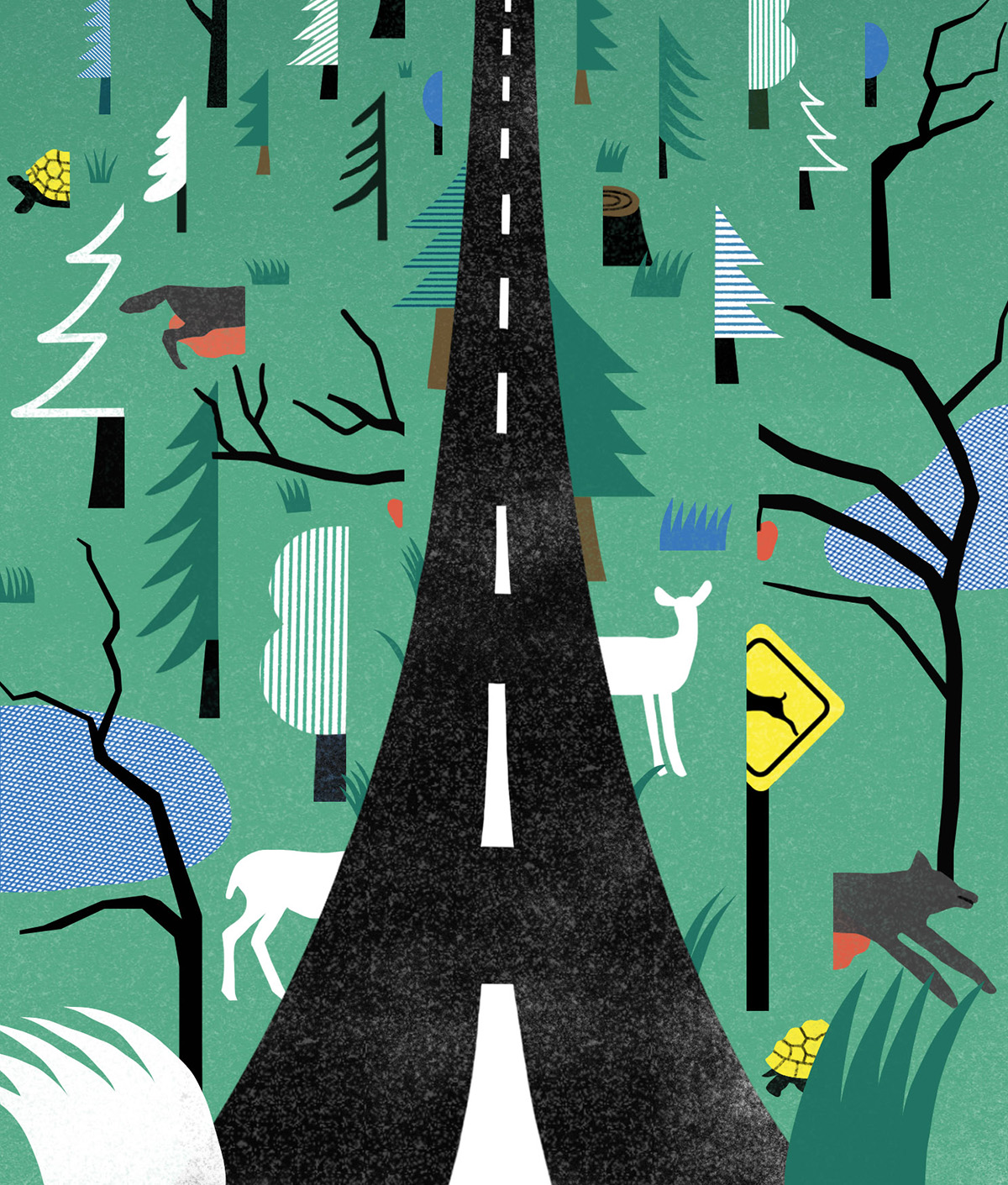The United States has 4 million miles of road, from paved highways to old dirt logging tracks, a tenth of all the roads that wrap the surface of the Earth. An enormous figure, but difficult to truly envision. Twenty miles, though, is a scale that’s easier to comprehend; that’s the farthest distance, anywhere across the entire Lower 48, that you can be from a road.
In his new book, Crossings: How Road Ecology Is Shaping the Future of Our Planet, Ben Goldfarb ’09 brings us in from a satellite view of roads ribboning across landscapes, down onto the asphalt itself, and then into the forests, swamps and cities those roads have sliced through. It’s there, out of sight of drivers, where much of roads’ greatest harm occurs. As Goldfarb’s reporting from across three continents makes clear, roads affect wildlife, the natural world and humans at nearly every conceivable scale.
Much of the first section of the book dwells on roadkill, the most obvious sign of a road’s impact (so to speak) on wildlife. But even the roadkill we think we’re familiar with—growing up in the suburbs in the Northeast, I’ve seen plenty of dead white-tailed deer on the side of the road, and had a few close calls—is only a fraction of the true toll. Many car-struck animals wander off to die in the woods, as Goldfarb writes, “scrambled and shattered and shocked.” And then there are the smaller creatures, the amphibians and reptiles and small mammals, whose soft bodies leave but little trace for other motorists to witness.
For all other animals besides humans, roads are fearsome landmarks in their world.
But beyond roadkill, roads form a “moving fence” of loud, bright, fast behemoths that prevent some animals, like all but the bravest (or most desperate) of California’s panthers, from attempting to cross them at all. Goldfarb details the ways that strange bedfellows of conservationists and highway managers have come together in recent years to install underpasses and overpasses for wildlife, which often pay for themselves in the avoided costs of deer collisions. (Despite their proliferation, the ubiquitous yellow deer-crossing signs do almost nothing). The Town of Amherst’s salamander tunnels, among the first such passageways in the U.S. for helping breeding amphibians avoid car tires, get a mention.
Goldfarb’s vivid, wry style leaves indelible scenes in the reader’s mind, like that of the Wyoming biologists who, in the course of taking measurements from captured mule deer, administer ice-water enemas to keep their charges from overheating. Or there’s the captured giant anteater named Evelyn: Goldfarb tries to make sense of her “tubular, velvety snout; curved claws, as large and hard as gardening tools; fanned bustle of a tail, coarse as broomstraw.”
For humans, Goldfarb writes, the road is not a place in and of itself; rather, it is “an interstice between places, a conveyance we use on our way elsewhere.” For all other animals, roads are fearsome landmarks in their world, or sometimes the human-circumscribed edges of their worlds. And yet Goldfarb also finds the creatures who call roads (or, more specifically, roadsides) home, refuges from the Midwest monocultures of soy and corn. Here, butterflies that once floated over grassland prairies can still find the flowers they evolved to feed upon.
While Goldfarb enumerates the myriad ways that roads disrupt wildlife large and small, he is not an anti-road partisan. Indeed, as he points out, he’s used America’s roads to see some of its splendors.
Five years ago, Goldfarb’s first book, Eager: The Surprising, Secret Life of Beavers and Why They Matter (winner of the 2019 PEN/E.O. Wilson Literary Science Writing Award) helped popularize and expand the “beaver believer” movement. Beaver believers maintain that one solution to the West’s water woes is the reintroduction of the once-prolific beaver, whose dams benefit trout, cattle and all the wild and domestic creatures in between (not to mention humans). As the world continues to explosively build roads and America sets about fixing its aging infrastructure, Goldfarb’s latest book makes the case for taking wildlife’s needs into account. By doing so, he argues, humans will benefit, too, whether or not we’re behind the wheel.
Giller is a writer of fiction and nonfiction. He is currently completing an MFA in creative writing at Columbia University.

